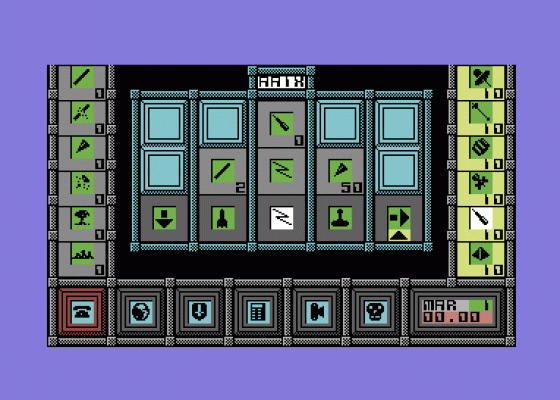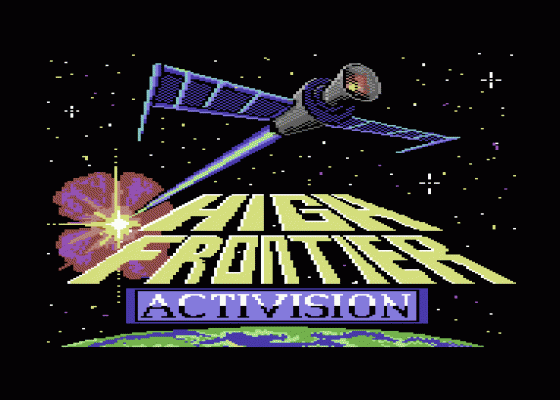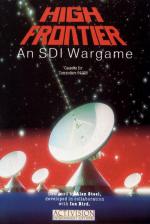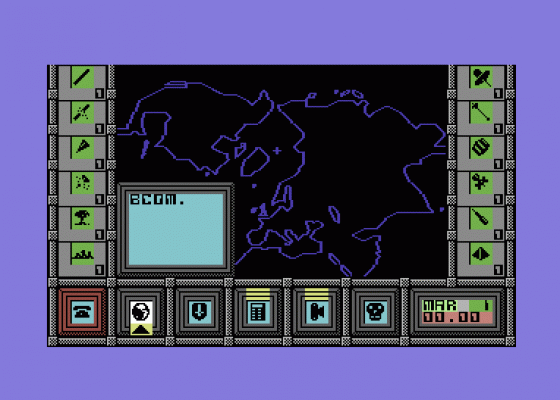
Zzap
 1st November 1987
1st November 1987
Categories: Review: Software
Publisher: Activision
Machine: Commodore 64
Published in Zzap #31
High Frontier
Apparently it was during the Vietnam War that the people of America first became thoroughly acquainted with the linguistic issue-dodging of the government. Euphemisms were used to make unpalatable things, like the bombing of peasant farms, sound scientific and inoffensive. Blurring an issue with long words has since become a hallmark of American administration, and that's why the anti-missile satellite defence system is solemnly called the Strategic Defence Initiative. In any case, a computer game calling itself 'Star Wars' would probably get into trouble with George Lucas anyway.
High Frontier is available on cassette and disk, though nothing is to be gained by owning the disk version as the two are identical. The blurb on the back of the inlay tries to make it sound like an exciting action-packed game, but the brief introduction in the tortuous rulebook gives a more accurate indication of its nature: "the player is in charge of the deployment and actual use of the SDI system". This is the only game I've come across which turns funding and manning scientific research into an addictive pastime, and despite its slick Activision packaging and presentation, it is very much a strategy game of the traditional, decision-making sort.
The Strategic Defence Initiative, or Star Wars as the Press and Mr Gorbachov call it, is basically a good idea. However, as far as I can gather, it doesn't really exist at the moment and seems to be more of a bargaining tool at disarmament conferences more than anything else. If it did exist, it would be a system of satellites ranged around Earth which would, in the event of a Soviet nuclear attack, attempt to shoot down missiles before they reached their targets.

High Frontier attempts topicality at the cost of making two large and decidedly dubious assumptions about the real world: that it is possible to develop one, or even several workable SDI systems, and that a Soviet missile attack is imminent and inevitable.
Although the objective of SDI is entirely salutory and definitely non-aggressive, there is something about the slick reality of this game that makes me decidedly uneasy. I've said several times in both Zzap! and Crash that the only kind of wargames I object to on moral grounds are those that force the player to take sides, and in particular those that foster the idea that the Soviet Union is on the brink of attacking us. It's not that I don't think that people who play strategy games can't tell the difference between fantasy and reality, it's just that we absorb cultural assumptions without realising it and I'm sure that a game which focuses the mind of a young teenager so sharply on defending the world against the Big Bad Russians can't be a very peace-provoking thing.
The game opens with an options selection screen, which allows the player to choose between three difficulty levels and three types of American and Soviet leaders. The leaders can be hawks, realists or doves. I suspect that 'realist' is another insidious American euphemism, and 'hawk' and 'dove' are self-explanatory. Although I've tried several different combinations, I'm not sure which makes things easier for the player; if you choose to have a 'hawk' for an American president you certainly seem to get more money to spend on developing weapon systems, and I assume that a Soviet 'dove' staves off the inevitable bombardment a little longer. There is little exposure to the mechanism of escalation, apart from the regular token and unconvincing menace reports, which tell the player in a random and contrived manner that the Russians are playing wargames or deploying extra units. But one of the major elements in the gameplay is that nuclear war is inevitable and is coming along sooner or later, so the player has no power to do anything about it.

Once the parameters have been set, the game goes into its main screen. It's driven by a complicated tree of icons, which look indecipherable on first loading. Fortunately, all the symbols are explained at length in the rulebook, with the help of numbered diagrams. The borders of the main screen show the number and type of satellites in orbit, while a bank of icons along the bottom allows access to the various sub-screens.
One of the icons sets time rolling. A useful feature of the game's design, and one of its strengths, is that time is frozen unless the player decides otherwise. There is none of the frantic absurdity of the real time strategy game, when manual dexterity becomes almost as important as it is in an arcade game.
The most important screen allows the player to build his own SDI system. There are six types of systems proposed, all with their own particular strengths and weaknesses. These are detailed, though not in a very conspicuous place, in the rulebook. Research projects require funding and manning, and the player only has so much of each resource to spend on the system of his choice. System development is measured in project stages, with each stage requiring a specified amount of each resource. The player has to keep up with these demands or the project will start to founder. Some systems seem to cost more and take longer to develop than others.
This procedure is curiously fascinating. Project costs vary, and completion times vary, and the amount of money which the President sees fit to grant for each stage is unpredictable; there is a great sense of satisfaction in seeing a lengthy and costly project get off the ground. It's difficult to develop and launch more than three systems in the time available, and the hope of spreading my resources more economically the next time encouraged me to press the Fire button for another game.
Once the system is underway, you can start to launch it in stages of ten satellites at a time. Another icon controls this and the arming and disarming of systems. Launches can fail, which seems to leave you with fewer units in the air, and neglecting to pay a completed system's maintenance costs causes it to start falling out of the sky!
The game closes with a detailed evaluation of the damage done by each system, so that the player can assess their effectiveness in future attempts.
This gives the impression of being a reasonably sophisticated and well-researched sophisticated and well-researched simulation of something that it is silly to think of simulating properly. In a jumbled and haphazard way, the rulebook gives a lot of detail about all of the possible weapon systems, and the gruesome details of the mechanism of a missile attack is analysed; this complexity doesn't seem to surface in the game, which is governed by simpler considerations.
The presentation is immaculate and each game is fast and involving, but there's nothing to provide long-term interest. This isn't a criticism, in this instance.
It doesn't try to be other than a short, neat entertainment product, and it succeeds at that. I'm reminded of Theatre Europe; a piece of software which is more of an experience than a game.
Verdict
Presentation 88%
An extremely classy on-screen appearance, and an unusually well thought out use of icons.
Graphics 85%
Highly representational, clear and attractive.
Rules 65%
Curiously confusing - everything is explained *somewhere*... however, finding it is the difficulty.
Authenticity 70%
A certain atmosphere is created by the ending, but as a simulation it's very abstract.
Playability 80%
If you're into funding scientific research... then this might persuade you to find it interesting.
Overall 74%
It's good for what it is - but don't expect to be playing it in six months' time.



